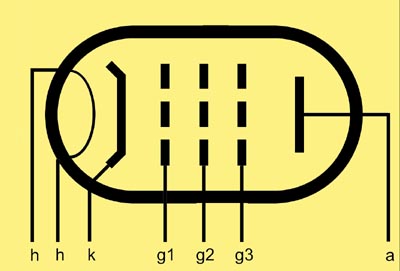|

The pentode was developed and patented by Philips. Mullard, by then a wholly owned UK subsidiary of Philips, benefited from the development.
The solution to the kink in the characteristic curve of the tetrode was found to be the addition of a third grid. This grid, called the suppressor grid, was made of a course wound helix of wire placed just in front of the anode. This grid was connected to the cathode (approximately 0 Volts) and was thus always more negative than the anode. The secondary electrons emitted from the anode by the action of the main electron stream hitting the anode was thus directed back to the anode and not to the screen grid. The valve can then be operated with much larger anode-voltage swings without distortion and without reduction in power output. The problem was solved!
The pentode was developed originally for the high anode swing involved in the output stage of radio receivers. The first appeared in 1927 and by 1928 the UK Mullard company was selling two pentode types under the Pentone trade name. The PM22 that had a 2 Volt filament and the PM24 that had a four volt filament. Both of these valves were dull emitters and were directly heated and so had to be heated by DC to avoid hum. The valves would have been used with accumulator supplies. The audio output was modest but adequate for a battery set. As the move to mains powered sets grew so the market developed new valves. In 1929 Mullard introduced the PM24A that was capable of 2 Watts output.
Producing a successful indirectly heated valve was a problem. The heating close to the control grid produced problems with grid emission. The prize was to achieve greater audio power output now that mains powered sets removed the high costs associated with producing several watts of power from dry battery anode supplies. The first really successful valve in this new class was the AC/Pen from Mazda, released in 1930. This set the pace for the other manufacturers to follow.
Other methods are also in use for suppressing secondary emission, for example, by increasing the separation between the screen and the anode until the secondary electrons have insufficient energy to reach the screen (as in the ''Harries Critical Anode-Distance Valve '') or by introducing small fins projecting inwards from the anode. In another method a pair of deflecting plates is fitted near the anode and connected to cathode or earth. Valves having this form of construction are known as beam tetrodes or kinkless tetrodes. The term ''kinkless ''refers to the absence of the kink which appears in the characteristic curve of the simplest type of Tetrode due to the flow of secondary emission electrons from anode to screen at low anode voltages.
Used in RF and IF radio amplifiers is the variable-μ pentode where the mutual conductance and hence stage gain is controlled by altering the grid bias voltage.
|